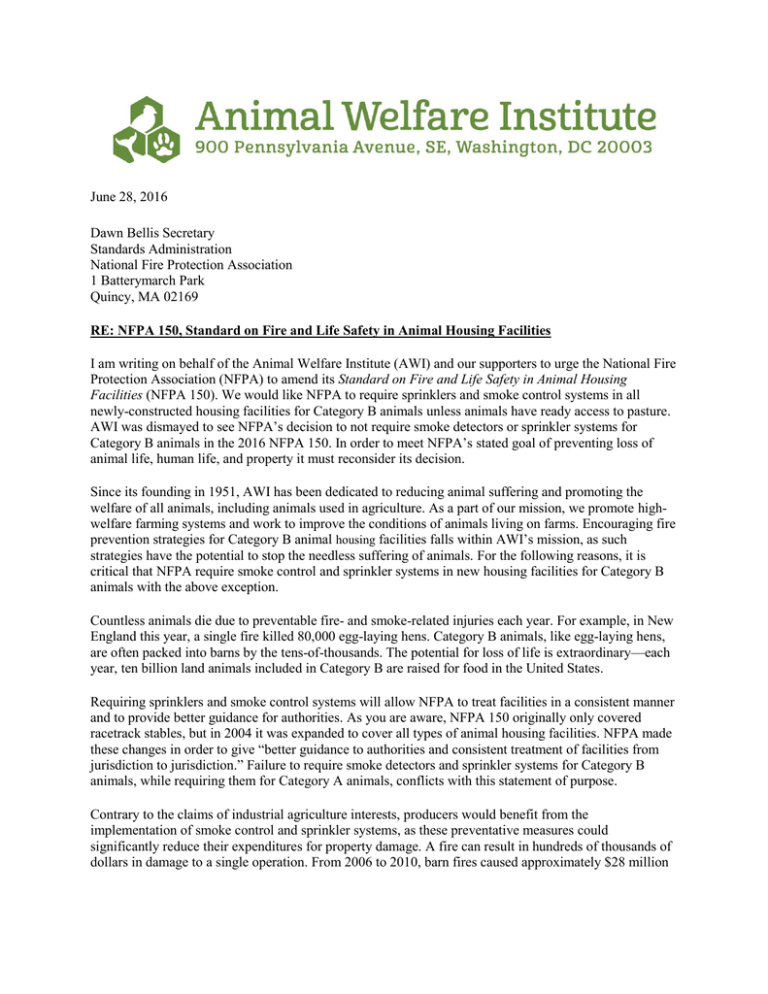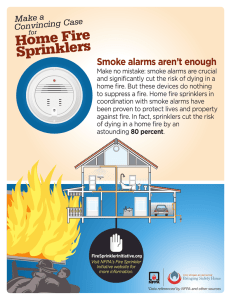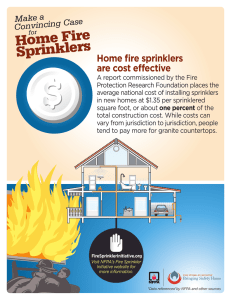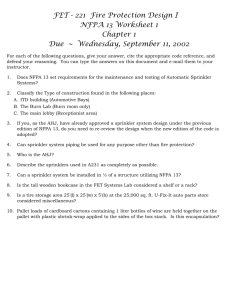June 28, 2016 Dawn Bellis Secretary Standards Administration
advertisement

June 28, 2016 Dawn Bellis Secretary Standards Administration National Fire Protection Association 1 Batterymarch Park Quincy, MA 02169 RE: NFPA 150, Standard on Fire and Life Safety in Animal Housing Facilities I am writing on behalf of the Animal Welfare Institute (AWI) and our supporters to urge the National Fire Protection Association (NFPA) to amend its Standard on Fire and Life Safety in Animal Housing Facilities (NFPA 150). We would like NFPA to require sprinklers and smoke control systems in all newly-constructed housing facilities for Category B animals unless animals have ready access to pasture. AWI was dismayed to see NFPA’s decision to not require smoke detectors or sprinkler systems for Category B animals in the 2016 NFPA 150. In order to meet NFPA’s stated goal of preventing loss of animal life, human life, and property it must reconsider its decision. Since its founding in 1951, AWI has been dedicated to reducing animal suffering and promoting the welfare of all animals, including animals used in agriculture. As a part of our mission, we promote highwelfare farming systems and work to improve the conditions of animals living on farms. Encouraging fire prevention strategies for Category B animal housing facilities falls within AWI’s mission, as such strategies have the potential to stop the needless suffering of animals. For the following reasons, it is critical that NFPA require smoke control and sprinkler systems in new housing facilities for Category B animals with the above exception. Countless animals die due to preventable fire- and smoke-related injuries each year. For example, in New England this year, a single fire killed 80,000 egg-laying hens. Category B animals, like egg-laying hens, are often packed into barns by the tens-of-thousands. The potential for loss of life is extraordinary—each year, ten billion land animals included in Category B are raised for food in the United States. Requiring sprinklers and smoke control systems will allow NFPA to treat facilities in a consistent manner and to provide better guidance for authorities. As you are aware, NFPA 150 originally only covered racetrack stables, but in 2004 it was expanded to cover all types of animal housing facilities. NFPA made these changes in order to give “better guidance to authorities and consistent treatment of facilities from jurisdiction to jurisdiction.” Failure to require smoke detectors and sprinkler systems for Category B animals, while requiring them for Category A animals, conflicts with this statement of purpose. Contrary to the claims of industrial agriculture interests, producers would benefit from the implementation of smoke control and sprinkler systems, as these preventative measures could significantly reduce their expenditures for property damage. A fire can result in hundreds of thousands of dollars in damage to a single operation. From 2006 to 2010, barn fires caused approximately $28 million annually in property damage alone.1 Preventative measures not only cost far less compared to significant fire damage, but also help producers save money by reducing insurance costs, increasing tax deductions, avoiding liability, and conducting regular business without disruption.2 In addition to savings for producers, the implementation of smoke control and sprinkler systems may reduce costs to taxpayers. Requiring smoke control and sprinkler systems could reduce the resources required by fire departments for extinguishing fires that could have been contained or prevented. In the fire killing 80,000 birds, over 20 towns dispatched more than 100 firefighters to stifle the blaze.3 Simply requiring that such facilities be equipped with smoke control and sprinkler systems will help to prevent such catastrophic fires and taxpayer expense in the future. Most critically, smoke control systems and sprinklers in newly-constructed Category B animal housing facilities will significantly reduce the risk of death and injury to animals, civilians, and firefighters. Farm facilities often house highly flammable and combustible materials such as fertilizer, hay, and pesticides. These substances allow fire to move quickly and spread throughout housing structures, making the fire difficult, if not impossible, to contain in a small area. Millions of animals have died excruciating deaths this way, and civilians and firefighters have been injured or killed by barn fires. Employees would have more time to get themselves and animals to safety if preventative measures were required. Early detection of fires through smoke control and sprinkler systems also gives firefighters more time to contain fires, which in turn decreases the resulting harm to animals, people, nearby buildings, and the environment. For all of the stated reasons we respectfully urge you to require smoke detector and sprinkler systems in all new housing facilities for Category B animals unless within the above exception. Thank you for your time and for considering the importance of preventative fire measures to protect animals from agonizing deaths. I would be happy to provide you with more information at your request. You can contact me at michelle@awionline.org or 202-446-2147. Sincerely, Michelle Pawliger, Esq. Farm Animal Policy Associate Animal Welfare Institute 1 Structure Fires in Barns Fact Sheet, NFPA available at http://www.nfpa.org/~/media/Files/Research/Fact%20sheets/barnsfactsheet.pdf. 2 Fire Sprinklers Save Lives and Money… The Economics of Retrofit, Kenneth E. Isman, P.E. available at http://www.firemarshals.org/pdf/F2%20%20FIRE%20SPRINKLERS%20SAVE%20LIVES%20AND%20MONEY.pdf 3 Lesson Learned 27 Years Ago To The Day Stops Spread Of Lebanon Fire That Killed 80,000 Chickens, Nicholas Rondinone, HartFord Courant, available at http://www.courant.com/breaking-news/hc-lebanon-fire-follow-042820160427-story.html.


